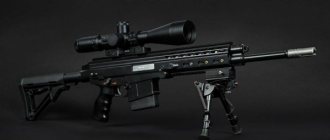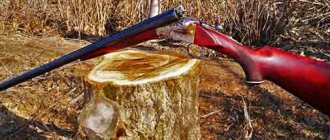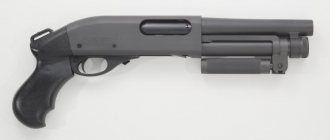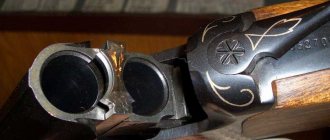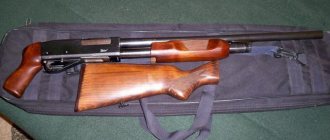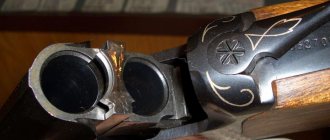Poor relative of an aristocrat: let's talk about horizontal lines
Photo by the author.
But before talking about the history of the origin of the IZH-58, it is worth looking towards its older brother, the IZH-54, whose production began four years earlier.
IZH-54 was the most complex and low-tech model in the entire post-war history of the plant.
The technical solutions used in the 54th were previously used on high-end shotguns.
Again, the 12 gauge of the 54 became an insurmountable barrier in the fate of the gun (in those years, the 16 gauge was still the most popular among Soviet hunters).
And until the appearance of the 58th, the choice of new double-barreled shotguns of the main hunting caliber was limited to two models: the hammer-operated TOZ-B and IZH-49 with internal hammers.
TOZ-B, a veteran of the domestic arms industry, whose production began back in 1904, celebrated its half-century anniversary in 1955 with another modernization.
This time he got a new wide block and the barrel block became noticeably wider. Hammer release and spring-loaded strikers appeared long before this event, and there was nothing else to modernize in the Model B.
And what was done was enough for Model B to be called BM from now on. The barrels remained black for another 8 years, until 1963, until the TOZ-63 came out, which was a BM, only with chrome-plated barrels and with an even more simplified shape of the hammer spokes.
But in essence and meaning, even the modernized BM was not far from the pre-revolutionary “tulka,” as it was usually called. She failed to look fresh and match the times due to her age.
| Photo by the author. |
I think it’s worth noting that after the war, double-barreled shotguns with external hammers disappeared from the scene almost everywhere, but in our country they remained in production for a long time.
And it’s not so much a matter of getting used to external triggers, but rather the ability to carry a gun with cartridges in the chambers for a long time, and carry it without harming the gun and without endangering others, and, if necessary, bring the gun into action in two short movements.
Yes, some confused the triggers and triggers, and therefore fired accidentally. But these are already features. The trigger also allows you to determine the condition of the gun just by glancing at it. Not a single gun with internal triggers will give such confidence, even if there are cocking indicators.
IZH-49 represented a completely different design school and a completely different approach. The pre-war Sauer model 8, taken as a basis, was repeated in Izhevsk using the actual cover method.
Everything was repeated, even the simple rectangular mating of the stock and the block and the side cocking indicators, which at that time was considered a sign of a fairly high-level gun. Unfortunately, the barrels were black and the gun itself had a considerable margin of safety, which was reflected in its weight.
I think it's worth noting that the gun was labor-intensive to manufacture and very difficult to repair. Attempts to disassemble it, as a rule, ended in damaged screw splines. Nevertheless, the IZH-49 in those years was a very worthy gun, and when it was discontinued, there were no alternatives to the TOZ-B model.
At the request of the workers, the IZH-57 appeared in 1957 in 1957 to produce a double-barreled shotgun with internal triggers. The same 54th, only in caliber 16x70. At that time, a black cloud of general simplification and cheapening was already hanging over the country.
The demi-block receiver units used in the first batch of IZH-57 seemed unnecessarily expensive. In order to reduce the cost of production and increase productivity, prefabricated barrel blocks were developed.
Separate barrel tubes, a separate coupling with milled hooks into which these barrel tubes were pressed. But even this achievement of the Khrushchev thaw seemed not enough. The block remained complex and expensive, and this slowed down the entire production.
| Photo by the author. |
And literally a year later, a gun with absolutely unimaginable consumer qualities was released. Everything seems to be clear with the receiver block. The locking remains the same, triple. But the Griner cross bolt was abandoned: it was expensive and difficult to fit. They made do with a simplified Westley-Richards doll head with locking not even on the bar, but on the protrusion of the Westley-Richards key.
There was also an opinion that this was not a doll head, but a rectangular barrel locking protrusion, borrowed from the Britt system and rotated 90° to open around a horizontal axis. But Britt had a vertical axis and the gun opened not down, but to the left.
However, this did not matter much. The fact is that the depth of the cutout in the block has decreased, and, presumably, the block has become stiffer than in the case of locking with a doll head or a Griner bolt.
The material of the block also changed: high-alloy steel of grade 50 A made it possible to do without fire pipes. The main thing was something else.
IZH-54, as well as subsequent models IZH-57 and IZH-26, were distinguished by rather difficult disassembly and required a set of high-quality weapon screwdrivers with a special width and thickness of the tip, otherwise the screws had a completely obscene appearance by the end of assembly, thereby indicating low technical culture owner.
The IZH-54 strikers were made separately from the hammers and collected dirt and carbon deposits in their channels, thereby preventing them from being released further into the block. The downside of this technical solution was that when using brass sleeves, there was a noticeable breakthrough of powder gases into the gap between the central bank capsule and the sleeve, to the forehead of the block.
This caused internal corrosion, which primarily affected the firing pin spring. And in order to change the striker spring, which had been eaten away by corrosion, it was necessary to unscrew the fire-pressure pipe - another technical task.
| IZH 58 is one of the last Soviet horizontal guns with triple locking barrels. Photo by Yuri Maksimov. |
The leaf mainsprings, inherited from the Sauer and resembling the letter V, broke quite quickly from frequent idle triggers. Yes, the gun was supplied with a spare mainspring, a spare firing pin and its spring, but any supply eventually runs out. The factory understood this.
They also understood that people needed something very simple, cheap and easy to understand, to be serviced with such improvised means as a screwdriver, hammer and drift.
This is what happened with IZH-58. Almost all the screws in the gun's design were eliminated, leaving a minimum - only those that are absolutely impossible to do without. The trigger mechanisms were limited to transverse axes on which the parts of both triggers rotated and were fastened.
The hammers were combined with the hammers, which was an obvious step backwards, and the cylindrical mainsprings were placed horizontally in the body of the block, in front of the hammers. The mounting of the stock was simplified to the last possible extent, taking as a basis the scheme used on the Kazansky single-barreled gun. A long stock screw passed through the through hole of the stock and was screwed into the shank.
Accordingly, to gain access to the stock screw, it was enough to unscrew the two screws on which the butt plate was attached.
The design features seem to have been sorted out, but what about the gun itself? For the first 15 years of its assembly line life, the IZH-58 was produced in two main calibers: 16x70, which in those years was the main hunting caliber, and 20x70, which was considered more of a fishing caliber.
I think it’s worth noting that the guns had different stocks, depending on the size of the barrel block. And assembling a 20-gauge gun on a 12-gauge block was somehow not accepted in those years.
| The front trigger is spring-loaded, which reduces the likelihood of finger damage. Photo by Yuri Maksimov. |
Mastering the model began with 20-gauge shotguns. IZH-58 in 20 caliber was mass-produced from 1958 to 1973. The production period can be divided into two stages: before and after 1960, with the bar flush with the barrels and with the bar raised above the barrels, respectively.
The largest batches of 58-20 were released in 1958 and 1959. The first batches of shotguns were distinguished by a steel butt plate on a straight English stock and a rotating swivel. After 1960, a half-pistol stock and a plastic, or rather carbolite, butt pad appeared.
The stock material used was birch or beech, although there is an opinion that walnut was used for craftsmen. The barrel length was 675 mm, and the weight of the gun was in the range of 2700 - 2900 g.
The IZH-58 has been produced in 16 gauge since 1959. And the mass production of guns in the main caliber was obtained at the cost of reducing to a minimum the number of produced 20-caliber guns. The shape of the stock is semi-pistol or straight, English. The length of the barrels until 1962 was 750 mm, then - 725 mm.
In 1972–1973, the IZH-58 12-gauge shotgun was developed. At the same time, it was decided to stop the production of 20-caliber shotguns, and to unify the blocks of 12- and 16-gauge shotguns in size. The design change added the letter M to the model name.”
At the same time, the shape of the forend changed. Initially thin and graceful, it became much larger. By 1977, it had already become known that the 1980 Olympics would be held in Moscow, and this was reflected in the design of the guns.
| The appearance of the IZH-58 can be said to be traditional and even elegant. Photo by Yuri Maksimov. |
In those years they were a reliable source of currency, and in accordance with the wishes of foreign buyers, all produced guns began to be equipped with automatic fuses, which is reflected in the name - IZH-58 MA.
And some of the guns were now assembled with ejectors, which added another letter to the model - IZH-58 MAE. The stock has also changed: its shape has been somewhat simplified in connection with the block.
The last change to the design of the 58th model was made in 1984. By that time, the IZH-43 had already been mastered, and as part of the unification of the IZH-58, the shape of the trigger guard was changed and the front trigger spoke was lengthened.
The main difference between the IZH-43 and the IZH-58 was the abandonment of triple locking in favor of double locking. The factory decided that they had reached the highest peaks in the field of creating locking units for breaking guns.
For some time, both models were produced in parallel, as long as the pads remained intact. When the pads ran out, IZH-43 remained the only Izhevsk horizontal plane.
Diana Ivanova October 25, 2022 at 05:45
Design features
The IZH-57 barrels are removable and are positioned horizontally. They are locked with two under-barrel hooks and one small one located on top. Cocking is carried out by the cockers at the moment the gun is opened.
The fuse is automatic and simultaneously locks the sear and triggers. The safety button is located on the block shank. The handguard of the IZH-57 is equipped with a lever latch, the stock is straight, with signs of pistol or semi-pistol shapes, and the descent is smooth.
The main external differences are the vertical trigger indicators located on the top bar of the block. In addition, there is no window provided for the front grenade hook; the transverse bolt has been removed and replaced with a locking plate.
The IZH-57 double-barreled shotgun has an extremely simple design, making the weapon quite easy to disassemble and repair.
Here are the main design features that a potential buyer should pay attention to:
- the barrel is locked using three combat hooks - two small and one large;
- automatic type fuse - activated when the striker is cocked;
- the stock is straight, half-pistol - helps soften recoil during a shot;
- the barrel locking system is represented by a lever latch;
- Vertical type trigger indicators are installed on the top bar of the block.
The gun has a swivel that allows you to attach a two-position or three-position belt to it for ease of movement through the forest. However, the mounts are located too close to each other, which makes carrying the weapon on your back not very comfortable.
Advantages and disadvantages of IZH-57
A few words about the positive qualities of the weapon, thanks to which many hunters still prefer this particular double-barreled shotgun:
- simple and reliable design;
- long warranty period;
- unpretentiousness in “nutrition”;
- relatively light weight;
- comfortable and ergonomic bed;
- presence of notches on the fore-end.
The 1957 shotgun also has a lot of disadvantages. Here are just the features that the vast majority of owners complain about:
- strong recoil with the barrel being thrown to the side, characteristic of double-barreled guns;
- not the best balance - the barrel tilts forward when aiming;
- low fighting qualities.
However, for many hunters the IZH-57 is the ideal horizontal double-barreled shotgun. In addition, almost 70 years have passed since its production, so it is already a kind of rare gun.
Execution options
The IZH-54 shotgun was produced in the following versions:
- Standard version - beech or walnut stock, stamped design “for engraving” on the block and a little hand engraving, price 90 rubles; Improved (piece) execution - the design was engraved by hand, the assembly was more careful, the price was 120 rubles;
- Souvenir (gift) version - hand-assembled and with various decoration options, price 170-220 rubles. and more.
In addition to these options, the 1958 edition of the “Hunting and Sporting Firearms” catalog mentions different degrees of “pieceness.”
The IZH-54 shotgun is also available in a piece version:
- IZH-54-Sh1 has good accuracy, improved finishing and engraving. The butt plate and rosette are shaded with colored edging.
- IZH-54-Sh has increased combat accuracy, improved finishing of parts and debugging of mechanisms. Decorated with various ornaments, figures of animals and birds. The trigger mechanism parts are chrome plated. The stock and fore-end are made from the best varieties of walnut. The butt plate and rosette are shaded with colored edging.
- The IZH-54-Sh2 differs from the IZH-54-Sh gun in its very high accuracy of fire.” A custom gun may be marked “IZH-54-SH” on the block, but most guns don’t even have the model name, much less the version, printed anywhere.
In the 60s, the IZH-54 was also produced for export. The engraving is simplified compared to the improved and piece versions, only an ornament, without images of animals, with a large wavy inscription “Made in USSR” on the sides of the block.
Shotguns of all versions, except for ordinary ones, have lead inserts in the butt to improve balance and position.
In addition to the hunting rifle, the IZH-54 Sport was also produced. It was sometimes equipped with two pairs of barrels of different lengths and, judging by the rich design, it was intended not for a stand, but for gifts to big people, because It was produced only in souvenir version on special order. Unlike the base model, the IZH-54 Sport Shotgun had lugs on the block, covering the breech of the barrels from the sides to prevent the appearance of a side shank, as on European shotguns. The weight reached 3.8 kg. Information about the IZH-54 Sport is limited due to the very small production volume; in fact, it was a custom-made weapon based on the components of the production model, each copy had its own characteristics.
Description
For the manufacture of gun barrels, 50PA steel was used; a coupling connection was made in the breech, where the tubes were pressed in and locked with a special pin. The main barrel part is connected by straps. One of them, located in the upper part of the IZH-26 gun, is considered to be sighting. The bar located below consists of two parts. Between them, at the breech, a hinged post was soldered in, and the forend was attached to it. In the middle, a pair of screws fixes the swivel for attaching the belt.
Decline of history
All three models of the Izhevsk plant - 54, 57, 26 - were three modifications of one gun, so they are considered to be one whole.
And many of their parts were simply similar in design to each other. However, the IZH-58 has already become a completely new gun, revealing a different story for the Izhevsk manufacturer.
Initially, the 58 model, which poor hunters could afford, was designed as a cheaper version of the IZH-54 gun, the price of which was quite high. But the unexpected happened: the IZH-58 completely ousted model 54 from production. The history of the great gun ended in 1969. The cheaper model IZH-58 put an end to this great story.
Storage and care
It is recommended to store the gun unassembled and locked in an iron box. The gun must be cleaned at least once every three months as a preventative measure. And each time after use, with special gun oil, while completely removing carbon deposits from powder gases.
Proper storage and care of weapons (especially old ones) is the key to their long life. So we decided to give our readers some tips on this matter:
- the gun must be stored in a metal safe;
- in winter and summer the room temperature should be approximately the same;
- weapons should be placed in the safe with their barrels facing up (otherwise oil will leak);
- The cleaning and lubrication procedure must be carried out after each use of the gun;
- Clean the barrel with a steel brush only when absolutely necessary;
- Before applying a layer of new oil, be sure to get rid of any remaining old grease.
The IZH-57 double-barreled shotgun is rightfully called one of the best double-barreled shotguns from IZHMEKHA. And despite the fact that this type of shotgun is almost no longer popular, many hunters still will not refuse to purchase this model, since it is considered the standard of what a horizontal shotgun should look like.
Specifications
Main technical characteristics of IZH-57:
- the trunks are horizontal, length – 75 cm, which is very impressive;
- the inside of the barrel and chambers are chrome-plated, which guarantees protection against corrosion and prolongs the safety of the weapon;
- chamber length – 7 cm;
- the choke constrictions create a good fight, the right barrel is narrowed by a choke, the left barrel is narrowed by a choke, which is very typical for most guns;
- the weight of the IZH-57 is 3.2 kg, which makes firing certain inconvenient at first;
- the forend is removable, the stock is straight or pistol, made of walnut or beech materials;
- 50-A steel was used for metal parts, giving the gun strength and reliability;
- removal of spent cartridges occurs with the help of an extractor, which perfectly performs its functions; very beautiful engravings in the form of images and traces of animals are applied to the block of the product;
- the gun can withstand at least 7,500 shots, but in reality much more are fired.


